|
SAINT COLMAN OF DROMORE
by Henry Murray
On an evening in October of 1992, The Dromore and
District Local Historical Group had the privilege of being
addressed on St. Colman, the Patron of Dromore, by Henry
Murray. His erudite lecture covered the growth of
monasticism in the early Church and it's spread in Europe,
before being introduced to Ireland by St. Patrick and
culminating locally in Colman's founding of his religious
settlement in the town in the early sixth century. We have
the honour and pleasure of presenting the following excerpt
from Mr. Murray's address:
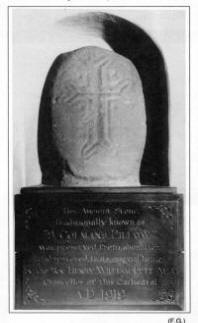 The
first mention we get of Colman of Dromore is in the Acta of
St. Coelan and the lives of St. Finnian. Colman was a
disciple of Coelan when the latter ruled as Abbot of
Noendron about AD 520. By this time, the monastic ideal at
Armagh and elsewhere in Ireland had grown in popularity, but
without serious interference with the episcopal constitution
which Patrick had established within the country. Colman is
referred to in different martyrologies as Colman or
Mocholmoca, founder of Druim Mor in Ui Echach Ulad (Dromore,
Co. Down). The foundation of Colman at Dromore is referred
to by the historians as one of the more important
foundations and ranks alongside those of Jarlath at Tuam,
Senan of Scattery Island, Fachtna of Ross (or Roscarbery in
Cork) and Bairre of Cork. All these were bishops. The Lives
of the Saints describe how Coelan (Colman's first teacher)
seeing the great grace with which the boy's soul was adorned
and the striking miracle which he wrought "sent him safe in
body and mind to other holy abbots, that he may see their
rules and their manner of Life, and study the scriptures
with them". The
first mention we get of Colman of Dromore is in the Acta of
St. Coelan and the lives of St. Finnian. Colman was a
disciple of Coelan when the latter ruled as Abbot of
Noendron about AD 520. By this time, the monastic ideal at
Armagh and elsewhere in Ireland had grown in popularity, but
without serious interference with the episcopal constitution
which Patrick had established within the country. Colman is
referred to in different martyrologies as Colman or
Mocholmoca, founder of Druim Mor in Ui Echach Ulad (Dromore,
Co. Down). The foundation of Colman at Dromore is referred
to by the historians as one of the more important
foundations and ranks alongside those of Jarlath at Tuam,
Senan of Scattery Island, Fachtna of Ross (or Roscarbery in
Cork) and Bairre of Cork. All these were bishops. The Lives
of the Saints describe how Coelan (Colman's first teacher)
seeing the great grace with which the boy's soul was adorned
and the striking miracle which he wrought "sent him safe in
body and mind to other holy abbots, that he may see their
rules and their manner of Life, and study the scriptures
with them".
Colman, like so many of his contemporaries in the sixth
century, was an abbot as well as a bishop. The question
arises: "Did the head of the Monastery rule thus as bishop
or abbot?" There is no evidence that the question was ever
discussed. But the fashion was to emphasise the spiritual
excellence of the Episcopal office by demanding of those who
held it a life of stern renunciation under a rigorous rule.
For much of the knowledge of the life of St. Colman, we
have to rely on popular traditions more than on reliable
historical documents. According to John O'Hanlon in his
"Lives of the Irish Saints," there were at least one hundred
and twenty bearing the name of Saint Colman. A story is told
that on one occasion, a new Abbot was appointed to a certain
abbey. In order to get to know the names of the monks, he
decided to bring them to the river for a swim and to call
out the popular names of the time. By so doing, he hoped to
get to know each monk. Unfortunately, the first name he
called was Colman, whereupon, all the monks jumped into the
river simultaneously. Folklore of course.
However, there are Manuscript Lives of Colman of Dromore
preserved e.g. in the Bodleian Library at Oxford, among the
Burgundian Library Manuscripts at Brussells, the latter
being described as "Vita S. Colman : E. Drum!." A further
manuscript life was in the possession of the Bollandists'
Library at Antwerp towards the end of the seventeenth
century.
According to the "Acts Sanctorum Hiberniae" (Acts of The
Saints of Ireland), St. Patrick, on two different occasions,
predicted the birth of St. Colman. On one occasion, whilst
travelling from Armagh to the monastery at Saul, he was
hospitably entertained by a bishop (one of the many Patrick
himself ordained) who at his departure offered himself and
his establishment to Patrick, to which Patrick replied,
"Thou art not assigned to me, but, after sixty years, one
must be born, who shall found his monastery in an adjoining
valley. There, a little while ago, whilst engaged in singing
Mass, I saw through the church window a great multitude of
angels assembled". On another occasion, to another bishop
who also wished to become subject to Patrick, the latter
replied "Trust me, I cannot receive you, because God has
destined you for a certain holy man, who will build his
monastery on the northern bank of a river called Locha. He
shall be venerable in the sight of God and man."
Whilst Colman is the name most commonly invoked, the
saint is referred to by other names. In the Aberdeen
Breviary, he is called Colmoc and in the Aengussian
Martyrology, he is referred to as Mocolmus. Other names
applied to him were Colmus, Mocolmoc and Colmanelus.

There is a great degree of uncertainty about the precise
date of Colman's birth, but he was probably born 470 A.D.
The Act Sanctorum, as taken from the Salamancan Manuscript,
assure us that St. Colman, Bishop of Dromore, derived his
descent from the Dalriads of Ards territory. This district
is also called Dalaradia, meaning the people or off- spring
of Araidhe. According to venerable Bede, Dal signifies a
part or portion, and was used to express a race or descent.
Hence Dal Araidhe or anglicised to Dalaradia. Its name
seems to have been derived from Fiach, surnamed Aradius,
King of Ulster. It is said that Colman was baptised by a
bishop, bearing his own name who was also his uncle.
According to accounts, Almighty God caused a fountain to
spring up suddenly from the earth in which Colman was
baptised.
As indicated previously, St. Colman's first teacher was
St. Caylan (or Coelan) who was the first Abbott of Nendrum,
who was afterwards Bishop of Down. Some years before
Colman's birth, a monastery had been founded by a Saint
Mochaoi, at a place called Nendrum on the Shores of
Strangford Lough where the ruins of three "Cashels" or
concentric circles of dry built stone walls can be seen
to-day after 1,500 years. They are on an island, joined to
the mainland by a short causeway called Mahee Island, after
the founder. The site has been professionally excavated and
is under the care of the state. A little bay on the nearby
Ramish Island has been known from time immemorial as
Colman's Bay. It was here, at Nendrum Abbey, St. Colman
studied under the aegis of St. Caylan.
During this period of study at Nendrum, Colman became
noted for his performance of miracles, through God's
assistance. Having received the benediction of Caylan Colman
set out to visit other monasteries and to learn all he could
from various abbots and their manner of living. Among those
he visited were Aylbeus (Ailbe) Bishop of Emly and Maonyseus
(Macnissius) Bishop of Conor. The latter has a prescience
concerning his guest's arrival and ordered all things
necessary for him to be prepared. Colman was received warmly
by Macnissius and Colman consulted him about establishing a
religious house, to which Macnissius replied: "It is the
will of God that you erect a monastery and within the bounds
of Coba plain". According to the advice given, Colman sought
the place indicated. In a valley, and on a spot, formerly
designated by St. Patrick, Colman established his dwelling,
probably before the year 514 A.D. when St. Mac Nissi died.
It was near a river called Locha, now known as Lagan.
This place now called Dromore, was situated in the
Dalaradian territory of which St. Colman was a native. The
O'Clerys gave Drum Mor the alternative name of Drum
Mocholmog, in Ui Eachach Uladh, according to the martyrology
of Donegal. Here, at Dromore, Colman trained a number of
fervent monks in the practices of the religious life, not
least of whom was St. Finnian of Movilla. During his
lifetime, the abbey was raised to an episcopal see of which
Colman became the first bishop. This is why he is reverenced
to the present time on 7th June each year as Patron of
Dromore Church and Diocese. In a very short time, his
followers increased greatly in numbers and they all observed
a very strict rule of discipline. St. Colman was, for all of
them, an exemplar of virtue by prayer, vigils and
abstinence.
No trace of the original monastery remains though it was
probably on the site where the present Church of Ireland
Cathedral stands. The medieval cathedral which was
previously there was destroyed during the 1641 wars.
In Appendix II of "Ecclesiastical Antiquities of Down,
Conor and Dromore" reference.is made to the hostile feeling
which prevailed in Colman's days between the ecclesiastical
and bardic orders. This might explain the story which is
told that on one occasion, when Colman was preaching in a
certain wood, he was approached by a crowd of bards who
demanded a gift from him. Colman said "At present, I have
nothing to give you but God's word". One of them replied:
"Keep the word of God for yourself, and give us something
else," to which Colman replied: "You foolishly reject the
best and select the worst of gifts". To satisfy their
curiosity, they then asked him to perform a miracle,
whereupon, the earth opened and swallowed them up.
According to the "Acta Sanctorum Hiberniae", St. Colman
is said to have thrice visited the tomb of the Apostles in
Rome. On one of these journeys homewards, carrying relics of
holy apostles, he visited the house of a King of Britain. On
the night of his arrival the queen gave birth to a dead son.
Through the power of God and the merits of the holy Apostles
whose relics he carried, Colman brought the child to life
and that child, whom Colman fostered and taught, was no
other than St. David of Wales who became a renowned Bishop
of Menevia. That is possibly why, in Wales there is a place
called Llangolman.
On 3rd November, 1991, a beautiful statue in stone,
carved and executed by the late Father Henry Flanagan, a
Dominican Priest, was unveiled and dedicated in the Catholic
Cathedral of St. Patrick and St. Colman in Newry, by the
present R.C. Bishop of Dromore, Most Reverend Dr. F. G.
Brooks. At the feet of the Saint rests a small deer or hind.
The story is told that our Saint once found a hind which had
strayed from its dam, and the Saint called the animal to
him, probably with a whistle or similar instrument
(described as ligni sono, or by the sound of wood). Then he
placed it with some heifers from which a calf had been
stolen. Soon the heifers began to treat the hind as if it
had been one of their own species.
At stated times, it herded with them, until at last, it
returned to its own dam. This little story is told to
illustrate that, although rough and rigorous in the practice
of asceticism in his own life, he was also compassionate and
kind to all God's creatures - man or beast.
The date of Colman's death is uncertain, but was likely
towards the middle of the sixth century and he is said to
have been buried in the "city" of Dromore which is most
probable. His Feast is celebrated on 7th June as his name
occurs on that date in the "Feiline" of St. Aengus, in the
Martyrology of Tallagh, in the Martyrology of Marianus
O'Gorman and in the Martyrology of Donegal. St. Colman is
also venerated in Scotland, as, in the Breviary of Aberdeen,
there is an office of St. Colmoc at 6th June. Again, in the
Calendar of Drummond referred to in Bishop Forbes' "Kalendars
of Scottish Saints", at 7th June is recorded Natalis of St.
Mocholmoc in Ireland. Likewise, in the "Memorial of Ancient
British Piety", the festival of St. Colmoc, first Bishop of
Dromore, is entered at 7th June. This possibly explains why
a church in Scotland is named after him, Inis mo-Cholmaig.
Historians have been unable to discover in ancient
records any Bishop of Dromore after St. Colman between the
date of his death and the arrival of the English in this
island except Maclbrighde, son of Cathasach, Bishop and
Abbot of Druim Mor-Mocholmog who died in A.D. 972 or 974 and
another named Rigan who died about the year 1101. It is
observed that, in the "Bibliotheca Pontificia" compiled by
Pope Honorius III before his elevation to the Papacy, there
is no mention of the See of Dromore. Some historians held
that in the dark historic period between the 6th and 13th
centuries, Dromore may have been amalgamated with the
Archiepiscopal See of Armagh as the bishopric of Dromore was
regarded as of lesser consequence.

BOOK REVIEW
"CAUGHT IN TIME" by W. A. Maguire, The
photographs of Alex Hogg of Belfast.
1870-1939, Friars Bush Press. �7.50.
Dr. Maguire has given historians a permanent record of
life in Belfast and beyond in the earlier part of this
century, with the production of this excellent book. Alex
Hogg was a professional photographer from 1901 until his
death in 1939 and during that time he left a collection of
photographs that capture the atmosphere of those days.
The book is divided into 15 sections which includes
Places, Linen, People at Work, Transport and Travel, Hotels
and eating places, City Scenes and many more.
His photographs portray the tranquility of Ardglass
contrasting with that of tobacco manufacturing at Gallaher's
factory in York Street. He captures the elegance of the
Grand Central Hotel and the ornate surroundings of the Grand
Opera House and audience as seen on Saturday 4th August
1917.
Transport is featured from horse drawn carts to Harry
Ferguson's aeroplane at Newcastle.
As well as the magnificent photographs a short biography
of Hogg, together with a brief history of Professional
Photography in Belfast before 1900, complements the book and
adds to its value as a reference work but primarily this
book will give hours of pleasure during long winter evenings
perusing life and work, people and places so many years ago.
-Bill Laney.

THE NEXT
BUS DUE ....
by Will Patterson
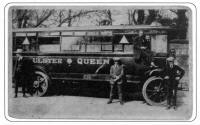 The
mode of travelling in the early days was by the railways
which were established in the early 1800's and linked up
most of the towns in Ireland. The
mode of travelling in the early days was by the railways
which were established in the early 1800's and linked up
most of the towns in Ireland.
Dromore and Banbridge lines were opened around the 1860's
by The Great Northern Railways and most people travelled by
train to their work all over the country. The train was the
undisputed king of travel though with the arrival of the
internal combustion engine other means of transport were
sure to appear.
In 1923 Alexander (Sandy) Spence formed a bus service
called Spence's Auto Services in Dromore. He was joined by
James P McCrea who was proprietor of a well established
retail business in Church Street, Dromore. McCrea had spent
some time in Canada and is thought to have been responsible
for bringing the first tinned fruit and food to his shop in
the early days.
The bus service was then called Spence and McCrea and was
the first public transport company to operate in the Lisburn
area. The "Ulster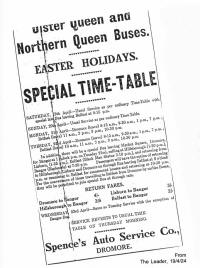 Queen", a solid tyred 36 seater was the first bus to leave
Dromore Square on a Wednesday in December 1923 at 9.30 a.m.
calling at Hillsborough and Lisburn and finally reaching its
destination some two hours later, the Black Man in College
Square, Belfast. Some three months later a second bus, the
"Northern Queen" was added to the route and the return trips
increased from twice daily to five times daily and two trips
on Sundays. With an increase in demand from such means of
transport a service to Banbridge commenced during 1924.
Queen", a solid tyred 36 seater was the first bus to leave
Dromore Square on a Wednesday in December 1923 at 9.30 a.m.
calling at Hillsborough and Lisburn and finally reaching its
destination some two hours later, the Black Man in College
Square, Belfast. Some three months later a second bus, the
"Northern Queen" was added to the route and the return trips
increased from twice daily to five times daily and two trips
on Sundays. With an increase in demand from such means of
transport a service to Banbridge commenced during 1924.
Others saw business opportunities in providing bus
services and William Jellie of Lisburn who owned a garage
and some other businesses in the town started a public
transport company known as the "Classic Bus Service." This
company was to provide 10 return trips during the week on
the main Lisburn to Belfast route. The journey took about
half an hour. There was also a service to Armagh city.
James Crothers and Alexander Dugan of Lisburn formed the
"Violet Bus Service", their first bus being built by E. J.
Pantridge of Dromore for the sum of �400. It was a 35 seater
Maudsley and it brought competition for the Belfast service
provided by Mr. Jellie.
The "Frontier Bus Service" was formed by Joseph Poots of
Ashfield and William Dunlop of Dromore in 1924 and their
principal route in the Lisburn district was Newry to
Belfast.
As bus services increased some operators felt that the
only way forward if the companies were to succeed was by way
of merger. James P. McCrea made such a move during the
winter of 1925/26 and as a result of his astute business
acumen the "Belfast Omnibus Company" was formed on April
23,1927. The merger included the 3 main companies in
Lisburn, Spence and McCrea, Wm. Jellie and Crothers and
Dugan. Mr. McCrea was the first general manager of the new
company and when the Northern Ireland Road Transport Board
was formed some eight years later 31- he retained the
position. The Belfast Omnibus Company appointed Wm. Jellie a
Director. James Crothers became traffic Superintendent of
the N I R T B. Wm. Dunlop of the Frontier Bus service also
held a senior position with the B0C and the NIRTB From until
his retirement.
The AEC (Associated Equipment Company) had a bus built by
the Dromore firm of E. J. Pantridge which was described in
the press as "an hotel on wheels." They operated 7 buses, 6
AEC's and 1 Lancia and were distinctive in their livery of
purple and blue. Names were given to the buses, the smallest
with pneumatic tyres being known as the "Wee Queen". Others
were called the Ulster Queen, Downshire Queen, Royal Queen,
Abercorn Queen and Northern Queen.
The advertising of the buses was most effective with the
Ulster Queen and the Northern Queen being described as the
"Aristocrats of Busdom" while others were advertised in more
poetic terms,
"At any point without much fuss, a hand put out will stop
a bus".
As competition increased the benefit was gained by the
travelling public as fares were reduced. Spence and McCrea
reduced their fares to 2�
d for the 17 mile journey to Belfast with workmen travelling
on Sundays incurring no charge.
By the early 1930's nearly every bus in the area belonged
to either BOC or H. M. S. Catherwood who had commenced a bus
service in Newry during 1925. All the companies were
eventually merged into the NIRTB in 1935.
Other operators in the Lisburn district who became
members of the BOC in 1927 were Henry Courtney who owned 3
buses with services between Lisburn and Belfast via Hillhall
and G. Gillespie who ran the Lisnagarvey Queen between
Ravarnet, Sprucefield and Belfast. Maxwell and McClean owned
the Cosy Bus service and operated on the Lisburn, Hillhall
and Belfast route.
Mrs. Peggy Craig is thanked for the use of the
photographs.
School
Winners - Civic Week, '93
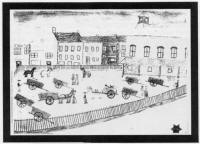 |
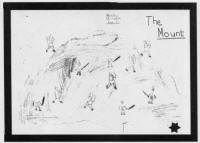 |
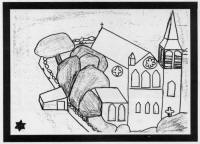 |
RACHEL MAGEE
Age 11 (joint winner) Central
Primary School |
WENDY WILSON Age 8. Carnew
Primary School |
JONATHAN McGREEVY Age 9.
St. Colman's Primary School |
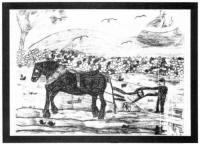 |
 |
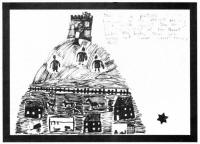 |
|
LYNSEY WATSON Age 11 (joint winner) Central
Primary School |
THOMAS CORBETT Age 6.
Carnew Primary School. |
PATRICK CUNNINGHAM Age 8. St. Colman's Primary
School. |

THE
PENNSYLVANIA CONNECTION
by Trevor Martin
Throughout the past few centuries Ireland witnessed an
emigration of it's people escaping persecution, famine and
eviction to find homes and enjoy civil and religious freedom
in the great New World of America. The Ulster connection is
well documented with no less than eight American presidents
like Grant, Nixon and McKinley claiming direct lineage to
Ulster. The local connection is further emphasied with John
Logan a native of Lurgan becoming the first governor of
Pennsylvania, a state renowned for it's religious tolerance.
In November of last year local solicitor and Chairman of
Banbridge District Council, Drew Nelson set out on a trip to
New York to investigate if there was any connection between
Dromore, County Down and the New World. On browsing through
an index in a research library he discovered a township
called Drumore which was situated close to the city of York
in Lancaster County, Pennsylvania. Determined to find out
more Drew contacted the Drumore township supervisors and was
soon to receive a reply from their secretary Mrs. Anna
Morris who was both surprised and delighted at this Irish
connection. She enclosed details of the Drumore Township
including a short history of the area which revealed the
fact we all eagerly sought.
Drumore was established in the early 1700's when
Presbyterians fleeing Ulster as they were out of favour with
a friendly government and an established Church eager to
maintain it's primacy in the country. It was confirmed as a
township as early as 1729 and as their town records state
"it was named after Dromore (Druim Moir) which means Great
Ridge a strongly fortified place in County Down". The
township account books for the years 1765 to 1800 show the
spelling of the name as Dromore, however over the years the
name changed to Drommore and thence to its present Drumore.
The area is gently contoured fertile farmland and the
plentitude of water led to farming as the main occupation.
With the discovery of iron ore many forges were constructed
in the area and a type of grain sickle made in the area was
transported and sold all over America.
The area which stretches from the Mason-Dixon Line to the
Susquehanna river contains some beautiful names which
conjure up peace and tranquillity such as Peach Bottom,
Fishing Creek and Muddy Run. It also contains many Irish
names with areas and farmsteads called Downpatrick,
Dungannon, Lisburn, Lurgan and Dundrum. The census records
of the early 1700's also reveal names which may be connected
with Dromore, Northern Ireland, these include names like
Steele, McKee, Cunningham, Knox and Patterson all still
found in this area.
Although these brave settlers escaped persecution in
Ireland they still faced dangers in the New World supplying
many notable soldiers for the American War of Independence
and the French and Indian Wars. General John Steele born in
Drumore in 1758 and aged only nineteen commanded a company
at the Battle of Brandywine in the War of Independence,
where he narrowly escaped death. Capt. William Steele whose
seven sons all enlisted on the same day fought with great
distinction at the battles of Germantown and Brandywine. A
distinct connection can be drawn with Lieutenant Robert King
a Revolutionary company commander whose father also called
Robert King emigrated from the North of Ireland making his
home in Drumore.
The Drumore Township Supervisors through Mrs. Morris have
eagerly taken up the connection with letters, phone calls
and literature winging its way back and forward across the
Atlantic. The local historical group has been heavily
involved throughout with copies of our journal, old
photographs and other documents sent across to Pennsylvania.
The group's competition for children organised as part of
Civic Week asked the kids to paint a picture of Dromore days
gone by. The winning entries were sent to Pennsylvania to be
displayed in their local school and hopefully further links
may be forged through that contact. The possibility of
twinning is currently being investigated with the Americans
already taking the lead in this regard. On March 4, 1993 the
township supervisors of Drumore officially declared "sisterships
between the two communities", this was an officially
attested document a copy of which was sent to the group.
Although Dromore does not have an independently elected
authority it would be nice to reciprocate in some way and
further cement the link that began over 300 years ago.

The Dennison
Letter
Further evidence of our early links with the State of
Pennsylvania was unearthed in the Public Records of Northern
Ireland in the form of a letter (dated 15th January, 1789.)
home from one, John Dennison, formerly of these parts but
then a new resident in the U.S.A.
Because of it's aged condition, it proved unsuitable to
reproduce the original document for this publication. But
efforts were made, in spite of the obscurity and ravages of
time, to transcribe the ancient communication for inclosure
as follows here. We are conscious of the unique glimpse of
his life and times in his struggles to make a fresh home for
himself in the New World. John Dennison speaks to us in a
simple, unpretentious voice from long ago, in the
straightforward fashion of his race.
Letter from John Dennison, Pennsylvania to
Sam Dennison, Dromore 1789.
January 15th, 1789.
Dear brother I received your letter dated January
the second seventeen hundred and eighty nine which gave
me great satisfaction to hear of you and your family
being well and likewise of my sisters and their famileys
and I can inform you that I and my familey is well
hoping you and yours is in the same condition at
present. I am sorry to hear of the death of my father
and brother but we have a right to submit ourselves to
the will of providence in all things.
Dear brother as for the situation in our country.
It is large and extends far to the west so that although
it has suffered much by the late war and brought to the
necessity of paying taxes yet by going back we can live
easy but now the taxes is got (bitter/ better). I myself
pay for three hundred acers of land, six horses and
eight cows, no other property is taxed here.
Dear brother you wanted to know what (work?) I
follow hear and my first employment in the country was
weaving at which I made ten shillings a day (?) at some
sort of work. The price of weaving is a penny a hundred.
A labourer has two and sixpence a day. Shoomakers 3sh a
pair for making shoes. Millwright for making a mill with
one pair of stones �75.0.0. Our land produces between 20
and 30 bushels to the acer of wheat, indian corn and ry.
Wheat sells four shillings per bushel hear but at
the Landing sometimes 6, 7 or 8 shillings per bushel.
Indian corn and ry sells for 3 shillings a bushel. If
you care to know I was at the war out with the militia
for four months and was in the Battle of (?) ermenton
but received no harm.
I now live upon the water of Iuniata province of
pensylvania Huntingdon county, franklin township about
one hundred and fifty miles from Baltimore and I follow
farming now. Land can be purchased for twenty shillings
a acer which is then free only paying the tax. I have
given a small account of the contry to you and if you
thought it answered you to come I would be fond to see
you hear but I cannot take it upon me to advise you but
if you ware hear you might do well and if you ware hear
and settled nigh to me I would not see you want until
you would have time to fix yourself.
When I left you I went to the mountains but I did
not like that place.
When you write please let me know in particular
how my sister lives and who my young sister is married
to. I have three children now Samuel, James and John
when you write direct your letter to the care of Samuel
Edie Eq. March Creek Settlement York county province of
Pensylvania and to me at the above. I and my wife joyn
in sending our compliments to you and your familey
brothers and sisters and all Enquirung friends and I
shall subscribe myself your loving and afectionate
brother until Death.
John Dennison.
To Mr Samuel Dennison
to the care of counsil J Waddel Eq
of Springfield near Dromore
County Down Irland.
(sic passim)
Where the document is unclear this has been duly indicated
in the transcript.
Our readers should be aware of the importance of such
correspondence in the area of local history. What at first
glance may appear to be only commonplace may hold a wealth
of information invaluable in `telling it as it was' for the
common man. The Historical Group would appreciate hearing of
any letters in private ownership from those now far afield,
be it in the U.S.A., Canada, Australia, New Zealand or
elsewhere abroad, which might prove to contain some insight
into their experiences in encountering life in a new land.
It should be borne in mind that Local History embraces not
only `the rich man in his castle but the poor man at his
gate'! Which is the most important is a matter of opinion.
But `the poor we have always with us'!
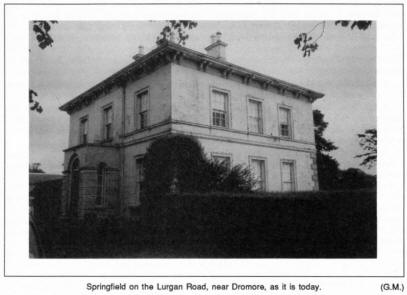

FUN
AND GAMES EARLY THIS CENTURY
By Muriel McVeigh
All work and no play makes Jack a dull boy. It has been
ever thus as those in the early part of the twentieth
century learned when they practised their cursive writing
with the aid of the Vere Foster copy books prevalent in
every National School in Ireland.
`It must have occurred to the inhabitants of every
locality that Jack should be prevented from becoming dull,
so there was always something arranged to incorporate the
inhabitants in activities designed to keep young people
alive and interested as well as entertaining the more
advanced in years. It cannot be denied the churches played a
large part in keeping their members, young and old, occupied
winter and summer by meeting together for recreation and
amusement as well as worship. Garvaghy district was well
served with its Church of Ireland and Presbyterian buildings
situated close by while not so far away was "Big" Dromara,
the local name for First Dromara Presbyterian, and "The
Glen" or Kilkinamurry Presbyterian and on the other side of
the hill was Ballela Chapel of the Roman Catholic faith.
I imagine it would be difficult to find anyone who grew
up in the area without having been affiliated to one church
and Sunday School or another.
Apart from learning the tenets of the particular
denomination of the parents the children got to know all the
others in the vicinity and shared in similar amusements, be
it learning to make a mouse from a pocket handkerchief
during the sermon when very young or mastering the
intricacies of the valeta or lancers at a later age.
Not all of the churches celebrated the successful
gathering of crops by Harvest Thanksgiving services, but
those who decorated with fruits and flowers to hold extra
services, found their buildings filled to capacity with
young people from far and wide who had come on foot or
bicycle hoping not only to take part in worship, but to have
the added advantage of meeting someone new and alliances
were formed which often lasted for a lifetime. A common
sight in those days was a line of bicycles manned by young
men who had managed to rush out of the church to get their
carbide lamps going to light up the gateway and illuminate
the young ladies as they came out, - many an offer was made
to supply an escort home. No doubt quite a few happy
marriages began in such circumstances. Some churches marked
the dark of the winter with a `soiree' when the church
building packed with young and old saw the occupants enjoy a
repast of currant bread, (big fruit loaves sliced - no
butter), and tea followed by a concert of song, recitation
and joke. Concert parties from Dromore or Banbridge were
engaged to provide this entertainment and they had to be
good to withstand the keen criticism of the country youth
who had no compunctions about saying exactly what they
thought of the items. These evenings provided another chance
for young people to get to know each other on the way home.
Schools under church management were used for evening
recreation and First Dromara had a healthy Young People's
Guild which met periodically and rounded off its winter
activities with a special social evening held on Easter
Monday when many singing and kissing games were enjoyed by
young people from all arts and parts. I remember walking to
one of these socials over roads white with snow which had
fallen earlier that day.

Box Socials constituted another form of winter
entertainment which were promoted in school houses or orange
halls. Ladies came along armed with a cake generally home
baked to gain entrance and males paid a nominal sum. A local
auctioneer was engaged to sell the cakes to the highest
bidder and when tea was ready, purchaser and provider shared
the repast after which dancing was engaged in till the early
hours of the morning to music provided by one or two
fiddlers, notably in the Garvaghy district William Wallace
or his son
John. These were occasions when it was useful to know
ones way through a set of Lancers or Caledonians or De-alberts
or various waltzes such as the Valeta or Pride of Erin, etc.
The evening provided much enjoyment for all who came and at
the same time made a tidy little sum for the promoters.
Summer saw the emergence of the "trip" or fete in a field
when the church to which I belonged invited every Sunday
school child to come to the field between the manse and the
meeting house to partake of paris buns and lemonade at
six-thirty followed by races of which the winners were
rewarded with small prizes of perhaps one shilling (5p.) for
first, sixpence (2�p.)
for second, and maybe a shiny silver threepenny piece for
third. By this time the lawn had started to fill up with
people of all ages led by Carnew Flute Band and big rings
were formed and tigging games commenced. Racing round these
big rings till darkness fell, boy chasing girl or vice versa
certainly used up a lot of energy and no doubt the older
folk standing around chatting got enjoyment out of just
being there and sharing in the friendships.
The arrangement of such "trips" spread to other
organisations as well as the churches so it was easy to find
one or two to attend every week to while away the long
summer evenings.
I suppose it is of such innocent occupations we are
thinking when we speak of the "good old days," for indeed
somehow life seems to have been simpler.
THE BADGE OF POVERTY
In the economic climate to-day, clouded
as it is with redundancies and lay-offs,
many of us have run the gamut of emotions,
from defiance to resignation, when faced
with those probing personal questionnaires
from the D.H.S.S.
The following extract from the BELFAST
NEWSLETTER of 9th February, 1757, while not
solving the problem may make us a little
less irascible when dealing with it.
The inhabitants of the Parish of Dromore
having seriously laid to heart the
distresses of many house holders occasioned
by the great price of bread of all sorts;
have opened a subscription for their relief
and in 8 days time have been able to divide
to 228 poor householders �261.17s.10 1/2d in
the following manner
| |
|
|
S. |
D. |
|
| to |
53 |
- |
3 |
3 |
each |
| |
45 |
- |
2 |
8 |
� |
| |
60 |
- |
2 |
2 |
|
| |
70 |
- |
1 |
7 |
� |
Which benefactions are resolved to be
continued and paid monthly during the
present distress and in order to carry the
said scheme the better into execution they
have agreed to furnish the poor of said
parish with badges, and give this notice to
all strolling beggers immediately to return
to their respective parishes otherwise they
will be punished as the law in this case
directs.
Source P.R.O.N.I Mic 77.
|

THE SAD DEMISE OF AN
INCURABLE ROMANTIC
By Roy Gamble
Dromore, at this point in time, is definitely not in the
running for the title of the most romantic place on earth.
Despite the fact that the town is surrounded by hills and
bisected by a fine river that winds under a pair of not
unpicturesque bridges, similarity with the Tiber and the
seven hills of the "Eternal City" is never more than
illusionary.
Rome it is not!
Not by any stretch of the imagination could the town's
charisma extend to the phenomenon of Frank Sinatra,
resplendent in seersucker suit and snap-brim trilby,
promenading past a moon-lit Neeson's corner and serenading
passers-by with a spirited rendering of "Three Coins in the
Fountain".
Time was though, way back in the fifties, when the
well-walked streets of the town (or city, if you take
cognizance of the strategically sited cathedral) possessed a
decided air of romance.
Even Church Street, that melancholic alley of eye-sores,
was once-upon-a-time an exciting avenue of entertainment.
Mock Not! It is quite possible that the faded facade of
its several buildings once witnessed a life-style not far
removed from the international bohemia of Parisian
Montmartre, the Piazza De Spagna of Rome, New York's
Greenwich village or arty Chelsea by the Thames. And the
above analogy with Rome may be more than coincidental
bearing in mind that Robert Dale's cinema (or picture house
as it was colloquially called) screened a rash of Italian
movies in my youth including the aforementioned "Three Coins
in the Fountain".
Also, a well-thumbed, slightly risque book (for the time)
by Albert Moravia entitled "The Women of Rome" may well have
had a bearing on the mental twinning of the two locations.
And of course there was Nicoletti's cafe (or "Nora Nicks"
as we conveniently abbreviated it in deference to the
waitress daughter of the Italian proprietor). That, plus the
combined imaginations of two callow romantics, me and my
friend Jamesy, was enough to add the gloss to the grand
delusions of two over-wrought minds.
Nora Nicks was the back-drop to our adolescent dreams. It
represented the slightly down-at-heel artistic cafe of Paris
and Rome and New York and London that we read so avidly
about. A life-style we lived vicariously in the fetid
atmosphere of sad cafe tea, rank vinegar and the bubbling
fat of deep-frying fish and chips.
So much of our time was spent in the "Frying to-night"
atmosphere that Mothers, sniffing outer garments, could
accurately judge, nearly to the minute, the occasion of our
most recent visit to the said establishment.
In a recess at the window just behind the door we
slouched over the formica, discussing Picasso's cubism, the
poetry of Dylan Thomas and the literary merits of the spare,
staccato sentences of our hero, the luxuriant-bearded Ernest
Hemingway, who, despite being true apple-pie American, wrote
an awful lot about Paris and Spain and Africa.
The conversation wasn't all high-brow of course for we
found time to debate our current "cops and robbers" novels
borrowed from Jackie Reid's lending library. Edifying
stories with homicidal titles like "Death is a round black
ball" and "Kiss me deadly", usually featuring tough,
hard-boiled "private eyes" with improbable-sounding names
like Mike Hammer and Johnny Dark.

To the combined saxaphones of Lou Bush and his orchestra
wailing out "zambesi" from the juke-box or the plaintive
voice of Connie Francis we sipped our appleade, trying
desperately to make believe it was "two fingers of bourbon"
so often swilled by Mr. Hammer and Mr. Dark, or some of that
nice red wine so beloved by Ernie Hemingway.
Often our concentration on loftier matters was shattered
by a posse of cow-dung scented, sweet-toothed tillers of the
earth, ravenous from an extended stout-tasting session in
some local hostelry, calling for "a wheen O buns and a
slabber O tay". Which was not how we imagined our idealistic
cafe clientele should speak at all, at all.
Outside, even in the coldest Winter, a continuous
crocodile of boys and girls passed our steamed-up window in
twos and threes on their Saturday and Sunday evening
perambulations.
Occasionally we joined them, sedately stepping out the
time-hallowed walk from the square to the Mill turn, perhaps
pausing to engage in a little badinage en route with the
little groups of arm-linked girls. Which led, on one
occasion, to a saddle-sore cycle ride to darkest Donacloney
to keep a romantic tryst, made, if I remember right, in the
heady atmosphere of the petrol pumps at the front of
Thompson's Hardware shop in Church Street. The epic journey
was not without incident, or accident for that matter, and
the whole business was doomed from the start when Jamesy, a
wobbly amateur on a machine borrowed from his cousin, made
an unfortunate front-wheel contact with a certain clerical
gentleman as he meditated of an evening - as was his wont -
upon the little concrete bridge that spans the river at the
Mill turn.
Fortunately the good man made a full recovery and went on
to preach many more intellectual sermons until his untimely
death many years later.
As for the rest of the escapade; memory fails me, except
I am of the opinion, although I can't be a hundred per cent
sure (well it was all of thirty-seven years ago) the
intrepid cyclists suffered the terrible ignominy of what is
euphemistically known as "being stood up".
Dromore was indeed a cafe society in the fifties. Besides
the notorious Niccoletti's, there was John Murphy's in
Bridge Street (managed by Jim Boal), and nearly opposite,
Billy Johnston ran an eating establishment above his small
confectionery shop. Here, those unfortunates, lacking the
wherewithal for a fish supper, could sample the savoury
delights of a mathematical - sounding dish called a "Fourpenny
half and half
Further up Bridge Street, near the junction with Castle
Street, Bertie Rogan and his wife Florence served fish an
chips. Mr. Rogan, reputed to have sojourned a while in the
great American continent, was prone to employing unique
mid-Atlantic expressions as he waited on table: "Flo, a
combination here please" being one of his more memorable
utterances. Combinations, it turns out, being nothing more
remarkable than Bertie's version of the ubiquitous fish
supper.
On the Eastern side of Market Square, sandwiched between
Poots' grocery store and Quail's butcher's shop, stood the
tiny cafe called the "Wendy Hut", (now, apparently, a little
piece of China named "Phun's welcome"). Here Kathleen Hichen
(or `Kathaleen' as some locals preferred her) served meat
pies and hot drinks.
The cramped pew-like seating arrangement (unlike the
widely- dispersed tables in Niccoletti's) militated against
the uttering of a fine flow of words. Nevertheless, insult
to the sensibilities of aficionados of bohemian cafe life
was often experienced as rather large gentlemen from the
direction of Slievenaboley Mountain or the wastes of
Blackscull, bellowed their orders, effectively killing the
delicate art of conversation.

I was too young to remember the hey-day of Bailie's cafe.
It stood on the North side of Market Square and was much
patronised by the many servicemen who frequented Dromore
during the Second World War.
Apparently its curtains became famous as look-out posts
for agnostic soldiers as they skived off the compulsory
Sunday parades that marched past the cafe en route to
Church. And speaking of servicemen, my youth was coloured
and imagination further fired as locals, serving in the
armed forces, returned from getting their knees brown with
exotic, and sometimes erotic tales from Hong Kong and Aden,
Malta, and Gibraltar, Singapore and Cyprus.
There was even a Dromore man who came home on leave one
Christmas to pass the time posing in his United States Army
uniform, "Shooting the breeze" at Dale's corner.
All was grist to the mill of an incurable romantic. But
things change, as they have a way of doing, for that is the
way of the world. The week-end promenade out the Banbridge
Road faltered and died; killed off by the cult of the car.
And when my turn came to leave home, as leave I must, the
cafe life of the town had died also. John Murphy, Billy
Johnston and Bertie Rogan switched off their deep-fat
fryers, ushered out their last customer and shut up shop
forever.
Kathleen Hichen gave way to the lure of the Orient.
As for Nicoletti's: the place of the stuff of dreams;
where two idealistic visionaries talked a torrent of words
on life's best laid schemes. Well, they simply pulled the
plug on the jukebox, bolted the door and brought down the
curtain on the end of an era.
BOOK REVIEW
"BANBRIDGE & DISTRICT HISTORICAL SOCIETY JOURNAL: Volume
Four" Priced at �3.00
The fourth volume of the Banbridge Historical Society is
enjoyable reading. The going ons around Banbridge all those
years ago were similar to what the people of Dromore were
doing. Many working in linen factories as described by Ernie
Gordon in writing about the Edenderry Works, playing in
Bands like the Tullyglush Accordion in an article by Walter
Porter.
There is a good description of Choirs, and of concerts by
the Choral Society, the Magennis Clan Rally gets a good
airing, and the "Burn Hill of Yesterday" deserves a mention.
Andrew Doloughan pens a fine tribute to J. Harris Rea, who,
I remember visited the St. John Ambulance Brigade in Dromore
during the War years.
Many more contributions and good photographs of local
interest, all add up to a splendid Journal. - P. Thompson.
 |